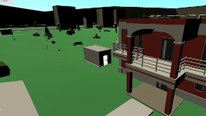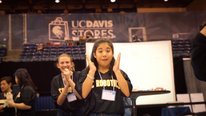- David Landy
- Assistant Professor
- Teaching the visual structure of algebra through dynamic interactions with notation
- http://graspablemath.com
- Indiana University
- Erin Ottmar
- https://sites.google.com/site/erinottmar/
- Assistant Professor of Learning Sciences and Technology
- Teaching the visual structure of algebra through dynamic interactions with notation
- http://graspablemath.com
- Worcester Polytechnic Institute
- Erik Weitnauer
- Research Associate and Lead Developer
- Teaching the visual structure of algebra through dynamic interactions with notation
- http://graspablemath.com
- Indiana University
Public Discussion
Continue the discussion of this presentation on the Multiplex. Go to Multiplex









Erik Weitnauer
Research Associate and Lead Developer
Hi all,
David, Erin, and me will be happy to answer any questions about Graspable Math! The software is available for free at https://graspablemath.com.
If you are interested in how to use our software in your research or teaching, please contact us at contact@graspablemath.com!
Sarah Haavind
Greetings David, Erin and Erik and visitors to Graspable Math!
I think your type of presentation, where the tool is already available free online with personalized support as you offer here, is a favorite at these showcases. I cannot wait to see what my math teacher colleagues think of this new tool for their toolkit! It is great to see that you have tutorials and suggested activities available on your website as well. Visitors, have you tested it out? Do you have questions or thoughts about how you might use it in your setting? Help us get the conversation started.
Breanne Litts
Assistant Professor
I appreciate the effort to make math more dynamic and interactive much like it is for an expert. It seems like this approach might make math seem more interesting to students. It seems like there are some fantastic opportunities for learning analytics across settings and populations to identify misconceptions and struggles. Has the project team done any of this work? Also, how is the data shared with teachers? My thought is whether and how teachers can "grade" each students' work and/or identify areas where an entire class might be struggling.I'd love to hear a few practitioner perspectives here! I'm also curious what sorts of technologies are needed in order to fully engage with Graspable Math. I saw a lot of touch screens and am wondering what this means for scalability and access overall. Moreover, in my own work, I've found that sometimes we introduce technology in contexts where it's not needed or wanted (i.e. in some cases folks prefer paper/pencil technology). What sort of response have y'all seen from students and teachers?
Erin Ottmar
Assistant Professor of Learning Sciences and Technology
Hi Breanne and Sarah and thanks for commenting! GM was developed out of an IES funded development project. As a part of this work, we have done a lot of iterative testing and research studies to explore its effectiveness in the classroom. We are currently creating analyzing and revising tools that allow us to do a lot of data analytics on student strategies and error and I am focusing much my current and future efforts on exploring and expanding the use of GM as an assessment tool for both teachers and researchers. We have created a strategy visualizer that both aggregates all solution paths of all students but also provides information about individual students and are hoping to make this tool more accessible to others in the coming months. I presented at AERA and NCTM this year on using the visualizer as an assessment tool at scale and the positive feedback has encouraged us to continue in this direction. Our initial studies were done on the iPad (through i0s apps) but the scale up goal has led to the development of GM and web-based/touch and mouse friendly options. In the fall we conducted a preliminary research study in an elementary classroom to explore whether there are differences between touch screens and computer mouse and have not found significant differences, suggesting that this approach is scalable on broad range of devices and modalities. In general, the students and teachers are all extremely engaged when using the technology and tend to prefer it over paper and pencil. As we further develop and disseminate the tool, we will continue to do research studies to answer questions just as you pose.
Amanda McGarry
What a fantastic interactive tool! I love the flexibility of it, as well as the sample teacher materials. I see you also have a chrome extension. Any plans for further integration into systems like google classroom?
Erin Ottmar
Assistant Professor of Learning Sciences and Technology
Thanks Amanda! Our hope is that we can integrate GM into many other existing tools used in classrooms. google classroom is definitely something we are looking into. Do you have any other suggestions of tools that you use or feel GM would easily integrate with?
Amanda McGarry
I could see it being useful in powerpoint, smartboard software, promethean software, or other platforms teachers use for their lessons.
Karina Hensberry
As someone who designs and researches interactive computer simulations, I see a lot of overlap between this project and what I do. This looks like it has a lot of potential for student learning! I'm curious about how you see teachers using it? For example, is it a replacement to the textbook and their regular instruction, or intended to supplement what teachers already do? Is it intended to be an introductory tool, or something to use after basics of algebra have been learned? Also wondering about the learning curve for teachers - how easy/difficult is it for them to learn and use?
Erin Ottmar
Assistant Professor of Learning Sciences and Technology
hi karina! We have explored using GM in several different contexts- as a teacher tool for facilitating instruction, as a homework tool, as a student tool, and as an assessment tool. There is definitely a learning curve for students and teachers to learn the gestures but we have found that it is fairly quick to teach- we are working on creating new materials and training videos activities and tutorials to help streamline this process. We have done research exploring the tool as an introductory preparation for future learning experience as well as for experienced learners. We have also used the tool With students as early as kindergarten and as advanced as college populations. these questions are much of the focus for my research agenda.
Nancy Shapiro
Associate Vice Chancellor
Very interesting! It looks like the kids are having fun with this tool. Have you had any negative reactions from students? if so, what form do they take? I'm glad you described it as a tool for teachers. I'm still trying to wrap my mind around the tool. Is it, in any way, related to what has been called "adaptive learning" technologies?
Erin Ottmar
Assistant Professor of Learning Sciences and Technology
Hi Nancy- Most students and teachers really enjoy using the tool. The biggest frustrations sometimes come with not knowing what they can and cant do within the system (which instantiate all of the rules of mathematics). To help with this, we have recently added an exploration feature on our website canvas (www.graspablemath.com) that provides highlighted scaffolding about what students can and cant do. We have no idea if this is empirically useful yet but we will be examining this in some controlled studies in the fall. I wouldnt consider GM to be an adaptive learning technology or a intelligent tutor in that it does not adapt to the students performance level- I would more compare this to other dynamic tools like Desmos or Geogebra.
Nancy Shapiro
Associate Vice Chancellor
Thanks, Erin. I can imagine that it will be really interesting to see how the student experience unfolds, and how they learn to persist and try different approaches to problem solving. I wonder if more of them will be interested in pursuing mathematics because they have this tool to experiment with?
Erin Ottmar
Assistant Professor of Learning Sciences and Technology
This is something we hope to test in the coming years with the tool. We have found in prior work that the approah helps serve as a buffer for the negative consequences of math anxiety on achievement which we feel is a really neat finding that is worth further investigation.
Jeremy Roschelle
Inspiring video -- great concept and wonderful that its available for free! Can you give an example of an insight about student math reasoning you've realized by examining their solution traces? Have you identified a new misconception? Great example of a teachable moment? looking forward to learning more!
jeremy
Erin Ottmar
Assistant Professor of Learning Sciences and Technology
Thanks Jeremy! We have had the derivation tracing feature for some time now but have not gotten to the point of testing that with younger populations yet. However, David and Erik might be able to provide some more insight on that as its been used with college populations out in Indiana at IUPUI. The misconceptions piece of this is something that I personally have become very interested in. One thing that we do notice is that the ordering and position of the numbers and operations seems to really influence what errors students make (ex. in the case of 3+5x, younger students often try to add the 3 and the 5. while this is certainly not new, the fine grained data and aggregation of the data provides a really efficient way to analyze, visualize, and observe these common misconceptions at scale. I believe that this could really help with assessments and Im hoping this will be my next GM research adventure!
Further posting is closed as the showcase has ended.